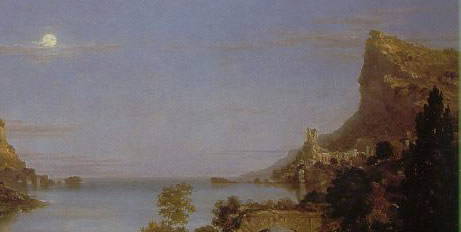 Beyond the Notes:
Beyond the Notes:
The Course of Empire
The Mountain Motif
Thomas Cole's paintings depict the transformation of a single landscape through the evolution of a civilization. (Visit Narrative and Context to learn more about how Cole uses landscape as a narrative device.) Landmarks in the landscape create continuity between the paintings - most prominently, a mountain cliff with a boulder perched on top appears in the upper right of each composition. The mountain may be seen as a representation of the forces of nature that will outlast fleeting human life (as seen in Desolation).
The mountain is reflected in the music by a recurring motif made up of the notes C Db G F C, which is transformed according the mood of each painting. See below for descriptions and audio excerpts showing how the mountain is represented in each of the movements.
First, hear the mountain theme out of context:
I. The Savage State

Appearing near the end of this movement, the mountain motif is clearly stated as melodic material and leads into two final chords.
Hear the theme isolated:
Hear it in context:
II. The Pastoral State

Here the mountain motif acts as a "cantus firmus": a technique originating in Medieval music in which one or more parts are composed over a pre-existing melody, which has been lengthened considerably (a technique called "rhythmic augmentation"), and appears in a single part (in this case, the cello). While the theme takes about 5 seconds to be played in its entirety in Savage State, here it lasts for roughly 1 min, 20 secs!
This excerpt from the score shows the contrast in duration between the cantus firmus (in the cello, the bottom line) and the parts above:

The theme is not immediately perceived by the listener because it is disguised and distorted by elongation, but it provides a subtext and lends a familiar character to the movement.
III. Consummation

This painting represents the moment at which human civilization dominates the natural world. The natural landscape upon which the city is built is almost competely obscured, and the mountain itself is built over with manmade structures--so the mountain motif, a representation of nature, is ommitted from this movement.
IV. Destruction

The mountain motif opens this movement loud and strong, and is considerably transformed from the placid character of the first and second movements. Fire, smoke, and barbarians overtake the city, and nature is out of balance. Here the motif is ragged and violent.
Hear the theme isolated:
Hear it in context:
V. Desolation

In "Desolation", nature fully reclaims the land that was once dominated by man. This movement opens with eerie sul ponticello (bowed close to the bridge of the instruments, producing a nasal, wispy timbre). The mountain motif is heard immediately in the cello. It is momentarily extended, leading into otherwordly music.
Hear the theme isolated:
Hear it in context:
The string quartet closes with the most prominent statement of the mountain motif, the representation of the everlasting powers of nature. The motif is traded between instruments and transposed in an extended sequence. The piece closes on an unresolved note, hinting at a future era of uninhabited nature.
Hear the final statement of the mountain motif: